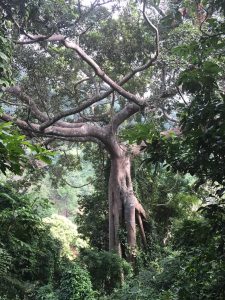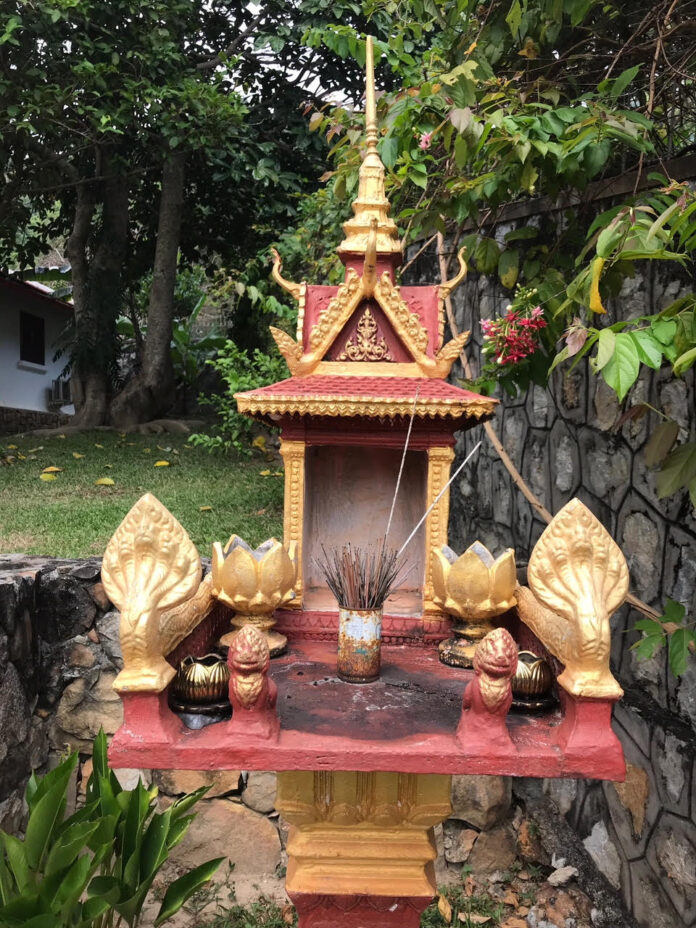MARINA SHAFIK –
In Southeast Asia, animism is deeply rooted into society. No matter what religion, status, educational or well-being level you are – animism is a constant and it is part of the cultural identity of the whole population. According to this archaic worldview, the physical and spiritual world intertwine, merging into the same dimension, where everything is “alive”. That’s how every natural element is believed to be moved by a common cosmic flow of vital energy.
Animism peers out over the daily lives of local people, resilient to the radical changes of contemporary society. For each skyscraper, hospital, shop, bank, modest or fancy building, in Cambodia as well as in Thailand, Vietnam or Laos, you’ll find a spirit house, which is the most widespread form of animism. These are curious miniature dwellings made of wood or concrete, perched on chest-high pedestals. It’s commonly believed that these mini households give shelter to the spirits of the place. Here, you can find food and drinks as well as other daily offerings. Sometimes, people even include small cars, elephants or airplanes – so that the guardian spirits can travel faster – or figurines of servants to wait upon them and dancers as a source of entertainment.
In Southeast Asia, it’s also quite common to see sacred trees. They can be recognized by a massive century-old trunk wrapped up in colorful ribbons and shrouded in incense smoke. Sacred trees can often be found near temples or the so-called spirit places – namely mountains, forests or geographical areas which are believed to have a soul. Cambodia is a country rich in these animated places: not only are they endowed with feelings and their own personalities but they can also alter people’s physical and mental health, or even their fate.

One of the most famous spirit places is Preah Vihear, at the border with Thailand. According to popular legend, since a post-Angkorian Khmer military commander named Ta Di was unable to stop an invading force from the Kingdom of Siam (Thailand), he jumped from the cliff of Preah Vihear. After this extreme act, he entered the invisible world and raised an army of ghosts to defend Cambodia. Many Cambodians, including high-ranking generals, still pray to Ta Di and believe that this phantom militia is why Thailand has never managed to win Preah Vihear. A less known spirit place is Haling-Halang. People believe that the spirits are so powerful in this forest that airplanes cannot fly over it and fire cannot burn it. The elderly people say that not even the thousands of American bombs, dropped in the area in the Sixties, could start any fire.
Finally, an equally powerful animated spot is the volcanic lake of Yeak Loam. Here, spirits of air, water and sky converge. Among the many stories told by highlanders, there’s one that explains how a local fisherman, frustrated at not catching enough fish, lost his mind right for having yelled profanities at the spirits of the lake. After doctors failed to heal him, a local “magic woman” performed a special ritual that cured the raving man.
The region is full of this kind of stories and of protected areas that are both feared and venerated by local communities – even sometimes by provincial governors. They believe that everything is sustained by the same invisible power, the so-called “breath of life.” In the West, we’ve progressively distanced ourselves from nature and the spiritual world. However, if we look closely, aren’t initiatives such as tree-planting for newborn babies, environmental art or green architecture ways to reconnect with “Mother Earth”?








